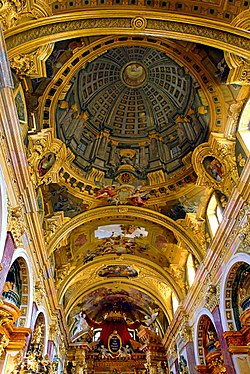
Architectural painting (also Architecture painting) is a form of genre painting where the predominant focus lies on architecture, including both outdoor and interior views. While architecture was present in many of the earliest paintings and illuminations, it was mainly used as background or to provide rhythm to a painting. In the Renaissance, architecture was used to emphasize the perspective and create a sense of depth, like in Masaccio's Holy Trinity from the 1420s.
Contents
- Western artists specialized in architectural painting
- 16th century
- 17th century
- 18th century
- 19th century
- Modern art
- Chinese architectural painting
- Notes
In Western art, architectural painting as an independent genre developed in the 16th century in Flanders and the Netherlands, and reached its peak in 16th and 17th century Dutch painting. [1] [2] Later, it developed in a tool for Romantic paintings, with e.g. views of ruins becoming very popular. Closely related genres are architectural fantasies and trompe-l'oeils, especially illusionistic ceiling painting, and cityscapes.






